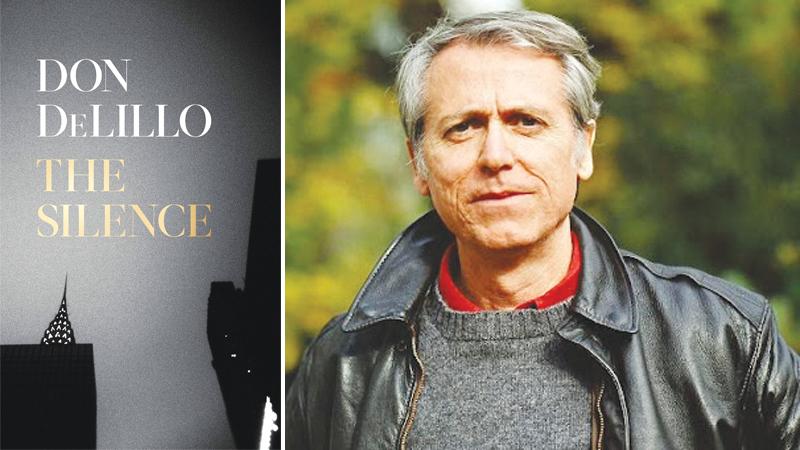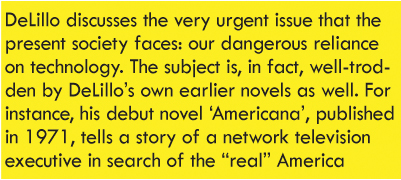
Name of book - The Silence
Author - Don DeLillo
Publisher – Picador
Pages – 117
One of the foremost and veteran writers of the United States,Don DeLillo’s new novel, ‘The Silence’, was released recently. DeLillo is a writer, who has long been preoccupied by the uneasy reality of western society. Through this novel also he talks about a present calamity - our crazy dependence on technology and its consequence to our life.
Silence story
‘The Silence’ is one of DeLillo’s short, curious novels, possibly the shortest and the curiousest. The story takes place in 2022, and it starts with a situation where five people gathered together in a Manhattan apartment, in the midst of a catastrophic event - they are retired physics professor Diane, her husband Max, her former student Martin and a couple, Jim and his wife, Tessa. The first three are waiting for the young couple who will join them from what becomes a dramatic flight from Paris.
 The beginning of the novel is intriguing. While they are waiting for the couple something eerie happens: no sooner does the football game begin than the TV screen goes blank. The phones are silent. The computer is dead. Martin suggests that the Chinese government may have launched “a selective internet apocalypse.” Diane makes a joke about aliens and imagines “all the people watching intently or sitting as we are, puzzled, abandoned by science, technology, common sense.” This opening sounds all the usual alarms of worldwide disaster: planes falling from the sky, cities plunged into darkness.
The beginning of the novel is intriguing. While they are waiting for the couple something eerie happens: no sooner does the football game begin than the TV screen goes blank. The phones are silent. The computer is dead. Martin suggests that the Chinese government may have launched “a selective internet apocalypse.” Diane makes a joke about aliens and imagines “all the people watching intently or sitting as we are, puzzled, abandoned by science, technology, common sense.” This opening sounds all the usual alarms of worldwide disaster: planes falling from the sky, cities plunged into darkness.
In this way, DeLillo discusses the very urgent issue that the present society faces: our dangerous reliance on technology. The subject is, in fact, well-trodden by DeLillo’s own earlier novels as well. For instance, his debut novel ‘Americana’, published in 1971, tells a story of a network television executive in search of the “real” America.
Writing for ‘The Washington Post’ Ron Charles says “DeLillo refers to ‘the human slivers of a civilization,’ but the plot of this novel is so attenuated that it conveys little of that precarious condition. As the hours tick by, these characters swing erratically from domestic banality to absurdist spectacle. Never have five people reacted with such existential dread to missing the Super Bowl. If they’d run out of guacamole, they might have jumped out the window.”
Characteristic of DeLillo’s fiction
DeLillo’s works are generally regarded as modern fiction, but some critics categorise him as a postmodernist novelist. Anyway, his works portray the anomie of an America cosseted by material excess and stupefied by empty mass culture and politics. David Remnick, the editor of the New Yorker, where DeLillo’s stories have often appeared, calls him a master. “If there are books that describe our age better than ‘Underworld’, ‘White Noise’, ‘Libra’, and ‘Mao II’, I really don’t know what they are. He sees deeply into who we are and, at the same time, anticipates who we are becoming. He is an astonishing, unique literary intelligence.”
“He caught something that was in the air,” says the writer Colm Tóibín, who has known him for almost 30 years. “A sort of paranoia, a sense that things were ending, an idea that nothing was not connected, and that much was a kind of illusion. The illusion interested him, and he set about finding a tone that would match an undercurrent in the world, a secret energy that had replaced reality and had become a reality that was more like echo than sound.”
As he further analyses, DeLollo’s sentences are needed to be bathed in irony because so many words and phrases had been used in advertising and speeches, so much language had been debased.
He observes, “I think he has a sense of the fragility of technology like no other novelist and a fascination with technology’s power and limits. He is not a psychological novelist, or a novelist who writes about feelings, but one who has a sense of reality that is hidden and can only be summoned up by offering hints and clues and images. He has an extraordinary command over not only tone but half-tone, not only voice, but the thing that was almost apparent, almost said.”
Inner thread of ‘Silence’
Don DeLillo completed ‘The Silence’ in March which is just weeks before the advent of Covid-19. The cause for the “semi-darkness” in the novel is not a pandemic, but a dramatic “loss of power”. Is it, as one character theorises, the Chinese? Have they “initiated a selective internet apocalypse”? No one knows, largely because they have no means of knowing. Here, the lines are dead, the screens are blank, and the technology is bust. Even the conspiracy theorists are going to find their audience tricky to reach now.
As Rachel Cooke puts in his article to ‘The Guardian’, “‘The Silence’ is a horrifyingly resonant book, and not only because the reader is bound to see herself in its pages, pathetically trying and failing to read her emails. The streets, quiet at first, and then, as panic sets in, crowded. The shameful notion is that we might more easily be able to live with a deadly virus than without our mobile phones.
The hearsay and supposition that soon tip into conspiracy theory. All these things make it feel like the weird apotheosis of at least one aspect of DeLillo’s art: a crystal ball between hard covers.”
In her review to the ‘Guardian’, Anne Enright, a Booker Prize winning author, says, “‘The Silence’ is just over a hundred pages long, so it is not as commodious a novel as ‘Underworld’, and not as funny as ‘White Noise’. Many of the same themes recur in a pared-down form, the novel illuminating the previous work with an intense, narrow beam. Sporting masculinity,
educators, other languages, systems, paranoias, what is remembered and what is forgotten, the mass mind; these are presented, not in a fritz of interconnectivity but as mimicry, emptiness and, finally, silence.”
She further elaborates, “Nobody speaks the way the characters in this novel do, nor are we asked to believe they would. They are, however, compelling and humane, and their voices have a ritualised urgency.
DeLillo is a master stylist, and not a word goes to waste. This is the novel as performance art, as expressionistic play. ‘The Silence’ is like watching Melancholia by Lars von Trier or an opera by Philip Glass – it always feels “foreign”. There is also something of the mid-1980s distilled and transported here: something rapt and male, full of longing for the machine and for the end of days.”
Enright sees DeLillo as someone who looks for the future as it manifests in the present moment. He has been using those themes for decades while other writers have been struggling with them. For example he takes the invention of the mobile phone, but others seem to think those themes would ruin the plot.
Enright says, “At 83 he makes many contemporary writers read as though they are thinking not even in the 20th but in the 19th century, one in which ‘the crowd’ did not exist, except, perhaps, as proles.”
Through ‘The Silence’ Don DeLillo definitely takes us not only to a new imagination, but also to a highland that we could oversee the world that we live in. Therefore, as with his other novels, it remains as a model for young writers.
